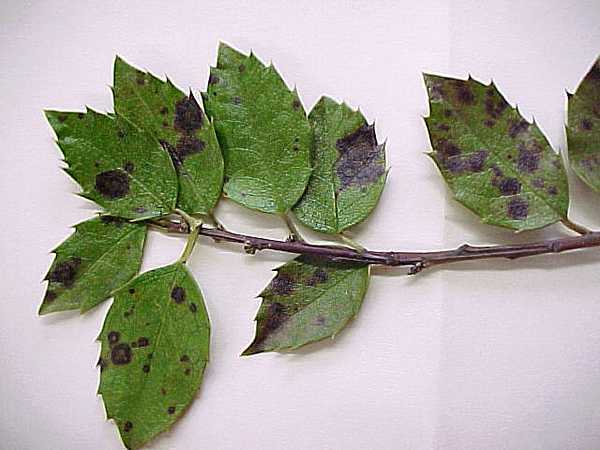Introduction
Holly leaf spot, also referred to as holly tar spot, is a fungal disease that affects holly plants. Holly tar spot induces the formation of black spots on the leaves of holly. Severe infections often result in extensive defoliation of the host plant.
Hosts
Leaf spot diseases are most common on American holly, and holly bush. They may also be observed on other species of Ilex.
Disease Cycle
Holly leaf spot is likely caused by several fungi, including Phacidium curtisii, Rhytisma curtisii, Coniothyrium ilicinum, Marcpderma curtisii, and Phytophthora ilicis. Infections occur on older leaves during winter and spring. When infected, leaves will appear abnormally spotted. Infection spots are irregularly shaped, and vary in size, ranging from large to small. As the infection progresses, the spots deepen in color, eventually turning black. As the black spots develop, a cushion-shaped stroma forms beneath the leaf epidermis. The orange-red apotheical discs mature the following spring, and release ascospores, which are disseminated by air currents or rain to other host plants, where they initiate new cycles of leaf infection.
Symptoms
Symptoms of holly leaf spot are easily distinguished. Most species of holly will develop tiny yellow spots on the leaves in spring. During summer, the spots gradually enlarge, turning reddish-brown. They develop into the characteristic black tar spot by early fall. Severely infected leaves drop prematurely. Defoliation generally occurs from the bottom of the plant, progressing upwards.
Management
- Plan holly bushes in conditions suitable for the holly type.
- Maintain plant vigor through sound cultural practices. Ensure that holly plants are sufficiently watered, especially during extended periods of drought. Apply a layer of organic mulch around the base of holly plants to improve soil quality, moderate soil temperature, and retain soil moisture.
- Routinely prune holly plants to promote sunlight penetration, and air circulation.
- Avoid watering holly bushes in the morning, or at night. Minimize leaf exposure to irrigation before midday. This will enable the leaves to dry rapidly during the afternoon.
- Fungicide applications on the shoots and leaves of holly plants will mitigate the effects of holly leaf spot. Initial applications should be performed in spring, just as the buds begin to swell. Two or three subsequent applications should be made during summer.
- Once the leaves fall, the disease cannot be treated. While this will temporarily reduce the ornamental value of the plant, the damage seldom lingers. In most instances, the host will survive, and produce a healthy flush of growth.
- Rake and dispose of any infected leaves. This will reduce the amount of inoculum available to initiate new infections. Avoid composting infected leaves; while composting will destroy most fungi, some may survive.
- Prune and dispose of infected leaves from holly plants. Disinfect pruning tools between each cut using a solution comprised of one part bleach and nine parts water.
Photo courtesy of Gail Ruhl.


